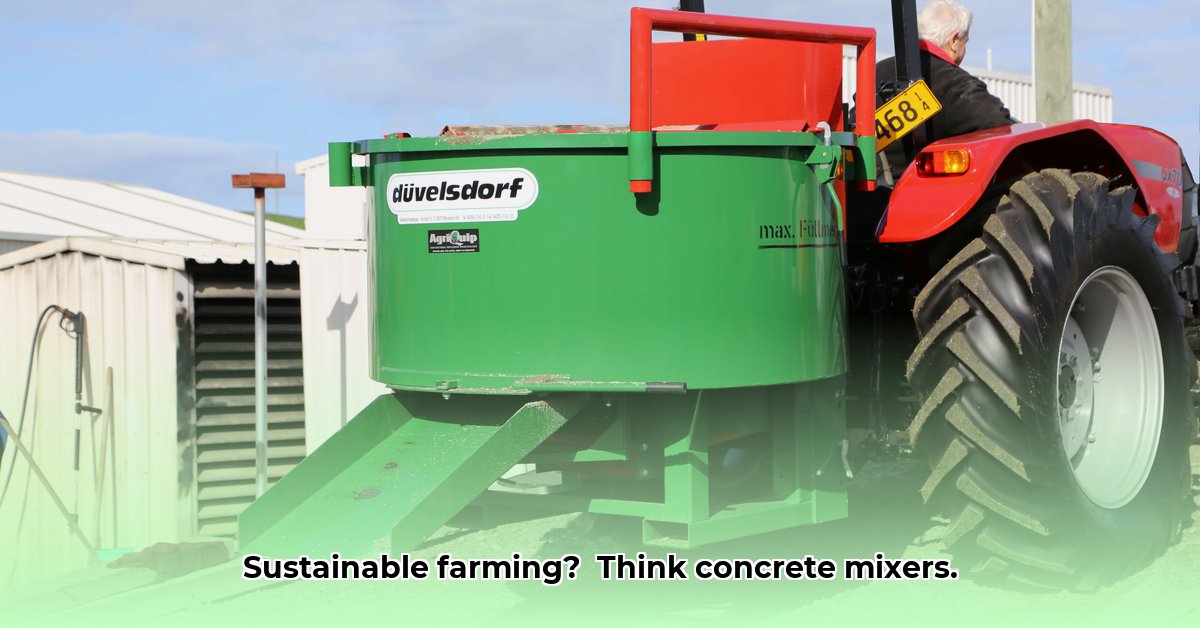
Concrete Mixer for Tractor: Sustainable Solutions for Modern Farms
The modern farm demands efficiency and sustainability. Building new structures or repairing existing ones often involves concrete, traditionally sourced from off-site suppliers. This necessitates transportation, impacting both cost and environmental footprint. However, a tractor-mounted concrete mixer offers a promising alternative: on-farm concrete production. This article explores the sustainability implications of this approach, weighing its benefits and drawbacks, and offering actionable steps for responsible implementation. For more on sustainable farm equipment, check out this resource.
The Appeal of On-Farm Concrete Production
Farm construction projects – barn renovations, fence repairs, and new infrastructure – frequently necessitate concrete. The conventional method relies on pre-mixed concrete delivered by truck, resulting in significant transportation costs and greenhouse gas emissions from vehicle fuel consumption. A tractor-mounted concrete mixer offers a potentially more efficient and sustainable solution, allowing for on-site concrete production precisely when and where needed. This minimizes transportation needs and downtime associated with delivery schedules. However, a deeper investigation is crucial to assess the true environmental impact.
Environmental Impact: A Closer Look
While on-farm mixing reduces transportation-related emissions, the production of cement itself remains a significant contributor to greenhouse gas emissions. Therefore, a simple comparison of on-site versus off-site mixing is insufficient for a full environmental assessment. The overall sustainability depends on various factors, including distance to the nearest concrete plant, the type and quantity of cement used, and the efficiency of the mixing process.
Advantages of On-Farm Concrete Mixing
- Reduced Transportation Emissions: The primary environmental advantage is the reduced greenhouse gas emissions from transporting pre-mixed concrete. Fewer truck trips translate directly to lower fuel consumption and reduced emissions, particularly beneficial for farms located far from concrete suppliers.
- Support for Local Businesses: Sourcing local aggregates (sand, gravel) supports local economies and reduces the environmental impact of long-distance transportation of these materials.
Challenges and Considerations
- Cement's Carbon Footprint: Cement production is a major source of CO2 emissions. This embodied carbon remains a substantial environmental concern even with reduced transportation emissions associated with on-farm mixing.
- Potential for Overuse: The convenience of on-site mixing could lead to increased concrete usage exceeding project needs, thus negating some of the environmental benefits.
- Initial Investment Costs: Acquiring a tractor-mounted concrete mixer represents a significant upfront investment, requiring careful consideration of long-term usage and cost-effectiveness against alternatives.
Lifecycle Assessment (LCA) and Comparative Analysis
A comprehensive lifecycle assessment comparing on-farm concrete mixing to the use of pre-mixed concrete involves several key steps: quantifying material usage, assessing transportation emissions (including material sourcing), calculating energy consumption during mixing and pouring, determining the embodied carbon of materials (particularly cement), and evaluating waste generation. Accurately comparing these factors requires detailed data specific to the location and materials used. While comparing the two approaches directly requires specific data, the above factors can guide a farmer in determining their ideal approach.
Actionable Steps and Best Practices
To maximize the environmental benefits of on-farm concrete mixing, several key actions are needed:
- Thorough Needs Assessment: Evaluate concrete needs carefully, considering design alternatives or substitute materials to reduce or eliminate concrete altogether where feasible. This minimizes unnecessary concrete production and its associated environmental impact.
- Sustainable Material Selection: Prioritize low-carbon cement varieties or explore cement alternatives. Source aggregates locally to minimize transportation distances.
- Precise Mixing and Waste Reduction: Mix only the amount of concrete needed to avoid waste and minimize material usage. Follow manufacturer instructions for optimal mixing efficiency.
- Equipment Maintenance: Regular maintenance ensures efficient operation, extending the mixer's lifespan and reducing overall material and energy consumption.
- Explore Alternative Aggregates: Investigate the incorporation of recycled materials (e.g., recycled concrete aggregate) into the concrete mix, provided it meets structural requirements.
Conclusion
On-farm concrete mixing presents a potential pathway toward more sustainable agricultural practices. However, successful implementation requires a balanced approach that carefully weighs the environmental benefits and drawbacks. Responsible material sourcing, precise mixing techniques, and a commitment to minimizing waste are crucial. Further research into low-carbon cement alternatives and optimizing mixer designs are essential for realizing the full sustainability potential of this approach. The future of sustainable farming relies on innovation and responsible environmental stewardship, and on-farm concrete mixing, when implemented conscientiously, can play a significant role.